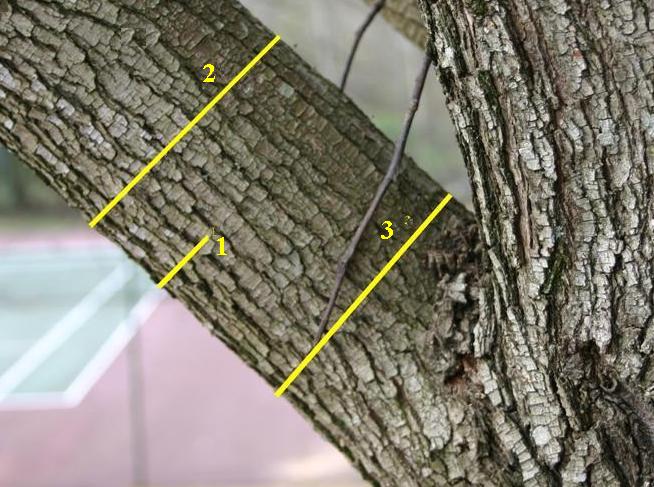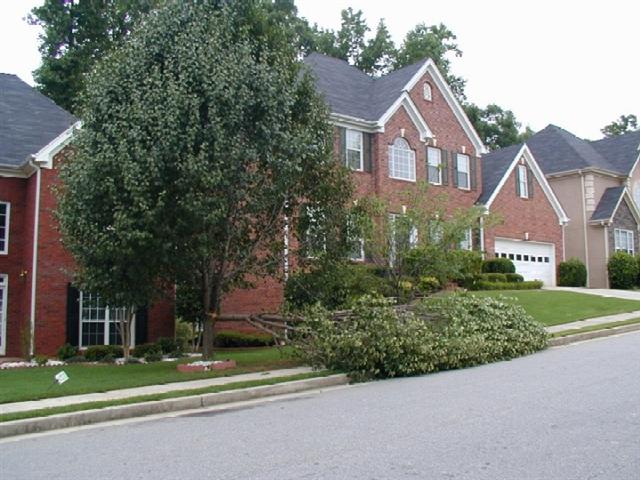Georgia Gardener Newsletter Design Tip: May 29, 2008
Busted Bradford Pear
This year's tornado season is one of the most active in nearly a decade. As a native Texan, there were times in my early
childhood when we had to dive into closets and head for the school hallways. In April 1998, the Dunwoody tornado tore
through my wooded back yard requiring us to replace a portion of the roof and clear out the downed trees. It was
a mess. This year, the metro area has been raked by one tornadic storm system after another since February.
Strong straight line or tornadic winds bearing down on trees that are already under extreme stress from dought can be a
recipe for disaster. Trees may have lost root mass, the dry soil could have pulled away from the roots and none of this
might be visible at ground level. Trees that appeared healthy could suddenly topple over in winds that may not have caused major
damage just a few years ago. Even if a tree is left standing, it may be leaning, have broken limbs or be completely
denuded of foliage. How do you sensibly and safely deal with these problems?
Immediately After the Storm
Once a storm has passed, your logical priorities are yourself, your family, your home AND THEN the damage to your landscape. Once
you have made sure that your family and home are safe and secure, you can venture outside to survey the damage. Do not try to inspect
outdoor damage at night. There may be hazards lurking in the dark such as semi-fallen trees, downed power lines, debris, etc. If
you home is secure, stay indoors until daylight.
Take a thorough and complete tour of your landscape. It's advisable to have a notepad and camera with you. Document all damage,
even if the damaged trees didn't impact any structures. Loss of mature trees (even if you didn't plant them) may be deductible
on your federal and/or state income taxes as a casualty loss. Consult a tax professional for more details.
Remove:
*Trees that are completely down whether snapped or uprooted (unless small).
*Large/medium trees that are now leaning.
*Large/medium trees that are missing more than 1/3 to 1/2 their height.
*Trees that have split.
*Conifers, such as pines, that have lost their crown.
Call in a licensed, insured and bonded
tree removal company to chop it up, haul away the larger pieces and grind the stump. Have them leave the portions they chip
as this makes wonderful mulch.
Potentially Salvageable with Professional Help:
*Large/medium trees that are missing 1/4 to 1/3 of their limbs.
*Trees that have lost all of their foliage.
*Trees with extensive or large broken limbs.
*Medium trees that are leaning or partially uprooted.
*Trees of personal or historcal importance that are still standing.
Call in a professional tree company that has Certified Arborists on staff (see below) and not "Bubba the tree guy" who happens to be
circling the neighborhood after a storm. With proper pruning, guying, or in extreme cases, cabling, a tree might be
able to be saved but the process may take time, be expensive and not always successful.
Do-It-Yourself Tasks:
*Small trees that are leaning or partially uprooted. Moisten the ground thoroughly around the tree and gently pull it towards
vertical. You will probably need to stake it for 6-12 months. See links below for proper staking techniques.
*Trees that have small or medium broken limbs that you can safely reach. Using sharp pruners, loppers or a saw, cut the branch
cleanly from the tree. For branches that are of a size that they might tear away from the trunk as you cut them, make the
following three cuts as shown below. Make sure your third and final cut is outside the branch collar. Do not apply any
paints or sealants to the wounds as they actually inhibit the tree's ability to wall off the damage.

*Use a sharp tool to cleanly cut away any torn bark. As above, don't apply any sealant to the wound.
After Care
Just like people, if a tree has suffered a major shock it's going to be more susceptible to secondary health problems
(pests and diseases). Make sure
to maintain a 2-3 inch layer of mulch underneath the tree, preferrably out as far as the branches extend. When permitted,
water the tree in the absence of rain. Applying root-stimulating fertilizers are fine, but try to avoid applying high amounts
of nitrogen for the next 6-12 months. Watch for signs of stress or problems and treat these early. When in doubt, call in a
Certified Arborist.
AND FINALLY,... Never, ever allow ivy to climb into any tree. It increases the damaging effects of both
wind and ice sometimes creating a load that even a healthy tree cannot bear.
Resources and Links
Storm Damaged Trees: Prevention and Treatment
A Guide to Successful Pruning
Landscape Tree Appraisal for Claiming Tax Deductions
Proper Tree Staking (Diagrams in Article)
Georgia Arborist Association
Copyright © 2008 by Theresa Schrum - All rights reserved
No part of this website may be reproduced without the expressed written permission of Theresa Schrum


